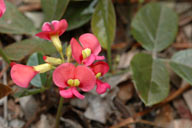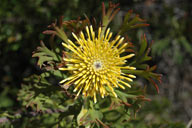In Flower This Week
A weekly news sheet prepared by a Gardens' volunteer.
Numbers in square brackets [ ] refer to garden bed Sections. Plants in flower are in bold type.
View past issues of 'In Flower This Week'.
30 September 2011
 |
Kennedia coccinea click for larger image |
So much of the Gardens are ‘In Flower This Week’! This weeks’ walk takes you around the Main Path loop. Allow 45 minutes. Begin at the Visitor Centre with a look at the stunning Orchid Display. These specimens are constantly updated, thus providing an ever-changing array of intricate flowers and scents.
Turn right as you exit the Visitor Centre and head along the Main Path and you will soon find the sculpture of a famous botanist. Take a moment here and smell the heavenly brown Boronia, Boronia megastigma[Section 174] …actually not everyone can detect its sweet perfume…don’t worry if you cannot, there are more scented flowers ahead!
Turn left at the grey signpost by the puffy cushion-like green and yellow wattle Acacia cognata “Green Mist” [Section 210]. As you enter the Rainforest Gully note the amazing array of different ‘greens’ and enjoy the cool, refreshing air. When crossing the Bridge don’t forget to look up and down at the various palms growing here; fan-like, spreading and shady with beautifully marked stems.
Further along on the right, stop to admire the beautiful cone-filled Wollemi Pine, Wollemia nobilis [Section 110]. A magnificent mature specimen of Banksia aemula (Wallum Banksia) [Section 15c] is interesting with fresh creamy-green flower spikes as well as different stages of fruiting cones, some with velvety seed pods showing, others dry and hard. Remember the famous botanist Sir Joseph Banks at the start of the walk…Banksias are named after him!
At the edge of the Rockery is the attractive low growing Grevillea lanigera [Section 15c] with nectar rich pink and cream flowers. Spilling out of the rock crevices near the waterfall is the beautiful yellow and white everlastings Rhodanthe anthemoides [Section 15v]. It is always intriguing to gently feel the crinkly dry flowers of this living plant. Take some time to enjoy the sights and sounds by the waterfall…you may see a Water Dragon basking on a sunny rock, Crimson Rosella’s bathing in the pool at the top of the falls or be treated to a chorus of frog calls.
For all those brown Boronia fans, another chance to enjoy its perfume whilst looking at the colourful trailing vine Kennedia coccinea [Section 15s] with its striking mix of pink and orange petals. Continuing along the Main Path, Acacia acinacea [Section 15r] is a lovely combination of fine green foliage and the typical yellow fluffy flowers. On the right side of the track, Indigofera australis [Section 4] is stunning with plenty of pink/purple flower stalks and rather sparse deep green/grey foliage. As you reach the lawn, look back towards the waterfall and see if you can spot the white Waratah, Telopea speciosissima “Wirrimbirra White”[Section 15r], an amazing contrast to the more usual red Waratah. Take the thin gravel path on your left for a close-up look at these interesting flowers and shapely brown seed pods. Retrace your steps and continue along the Main Path in search of the beautiful soft and crinkly Helichrysum elatus [Section 18] with its large white and yellow dry papery flower heads and soft silver-grey hairy leaves. What a contrast in texture between leaf and flower!
Onwards to the Sydney Region Gully where you will be greeted by some lovely, newly planted specimens of Telopea specisissima x oreades [Section 191]. It was a full house in the Grevillea sp [Section 191m] with three Eastern Spinebills all feeding on the numerous pink and red nectar-rich flowers on this mature shrub. Clearly a five star grevillea for honeyeaters!
 |
Isopogon anemonifolius click for larger image |
Just a little further along the track, enjoy the sweet scent within the dainty white flowers of Logania albifolia [Section 191d]. While having a look at the sandstone fossil, check out the attractive silk-like purple and yellow flowers of Solanum brownii [Section191l]. It’s hard to ignore the striking yellow flowers of Phebalium squamulosum subsp. lineare [Section 191h]. Check out the elaborate red, orange and yellow spidery flowers of Grevillea ripicola [Section 24]. The final plant is Isopogon anemonifolius [Section 26] with its beautifully decorative cones, yellow flowers and branched foliage. Enjoy the many flowers as you continue along the Main Path on your return to the Visitor Centre.
Sue Dowling
![Director of National Parks [logo]](../../../../images/dnp_90px.gif)






